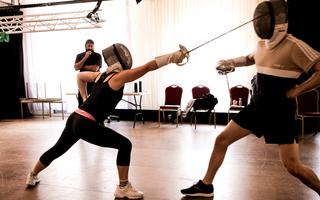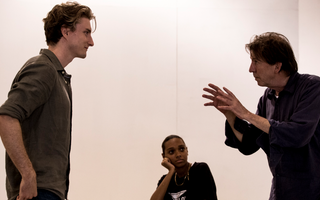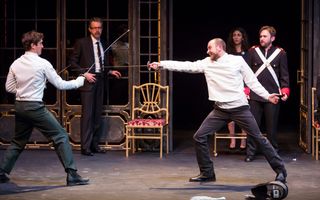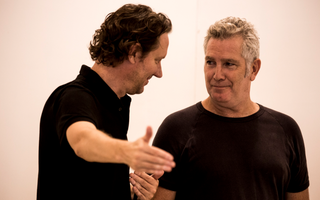 On Stage
On Stage
Delay and inaction
Hamlet’s (in)action is what spurs the plot of the play. Hamlet’s quandary arises from his constant fluctuations between deciding to “act” (kill Claudius and avenge his father’s murder) or instead, question the implication and meaning of such impulses. As soon as Hamlet is confronted by the ghost, he realises that he is performing the plotline of a revenge tragedy. Unfortunately for Hamlet, all Elizabethan revenge tragedies end in the death of the revenger (such as in The Spanish Tragedy by Thomas Kyd, another possible source for Hamlet). Hamlet knows that by taking on that role, he won’t have a happy ending. Hamlet’s hesitancy also arises from moral and religious issues: how can he retain the purity of his soul through murder?
Characterised as the archetypal student, Hamlet understands his world through the context of the university. As Coleridge writes, Hamlet is a “sensitive man paralysed into inaction by the sheer capacity for thought.” (in Bate et al, 2007). After the Ghost first speaks to Hamlet, he declares:
Yea, from the table of my memory
I’ll wipe away all trivial fond records,
All saws of books, all forms, all pressures past
That youth and observation copied there
And thy commandment all along shall live
Within the book and volume of my brain
Unmixed with baser matter.
Act 1, Scene 5
Hamlet can only understand his duty by ordering it within his sense of self as a student. However, Hamlet is still eaten up by guilt for his fecklessness. He chastises himself:
Why, what an ass am I: this is most brave,
That I, the son of a dear murdered,
Prompted to my revenge by heaven and hell,
Must like a whore unpack my heart with words...
Act 2, Scene 2
When Hamlet does take action, however, it is of a very random and rash nature, such as when he mistakenly kills Polonius in the ‘Closet Scene’. It is only very late in the play that Hamlet concludes that he must take proper action instead of creating useless scenarios (such as ‘The Mousetrap’) or only philosophise. In his final soliloquy, “How all occasions do inform against me / And spur my dull revenge” (Act 4, Scene 4), Hamlet finally resolves to take action: “O, from this time forth / My thoughts be bloody or nothing worth.” (Act 4, Scene 4). Hamlet comes to accept the need for action in order to resolve the revenge tragedy he finds himself living.
Moral corruption
Along with his many other fixations, Hamlet constantly returns to images of disease and rot, which frames the play’s theme of moral corruption. Not only a character study, Hamlet is a meditation upon power’s ability to corrupt one’s morals. Using pathetic fallacy (the technique of attributing human emotion to aspects of nature), the disfiguring of the natural world comes to represent the rot at the heart of the Danish court. As the famous line goes, “Something is rotten in the state of Denmark.” (Act 1, Scene 4)
In the Elizabethan era, the concept of the ‘body politic’ (a metaphor denoting the physical body of the monarch as well as the state; also known as “the King’s two bodies”) meant that a monarch’s physical and emotional state was representative of their country. The disruption in Elsinore begins to spread out into the rest of Denmark, and can only be restored once the wound is cleaned by the coming of Fortinbras. This represents the restoration of the moral order. Claudius is the heart of the play’s moral corruption, having killed the true king and married his wife. Claudius will stop at nothing to retain his hold on power – even at the end of the play, Claudius manipulates Laertes into murdering Hamlet. Laertes uses the metaphor ‘contagion’ (Act 4, Scene 7) for the poison he will use to kill Hamlet. The disease of power has rotted away the court so much so that many of the protagonists commit high treason.
Hamlet, too, obsesses over corruption. He is revolted by the world and the people within it:
... ‘tis an unweeded garden
That grows to seed, things rank and gross in nature
Possess it merely.
Act 1, Scene 2
The metaphors connected to this theme dominate the imagery of the play. Hamlet’s desire to cleanse the illness of the state, however, goes awry, as murder only begets murder. The continued corruption only comes to an end with the sad loss of the Hamlet line.
Masks, performing and theatre
Hamlet is a play about the theatre and performance, artifice, masks and the truths they conceal. It is worth considering here the significance of the newly built Globe Theatre in Southwark, where Hamlet was to be performed. Shakespeare’s plays written at the beginning of the seventeenth century make profound comments about the power of theatre itself, adopting self-reflexive meta-theatrical models as frameworks for the action.
Images of the theatre abound in the play, and lend themselves to questions of identity and action. Hamlet constantly ‘performs’ his identity to the court through his feigned madness. Furthermore, it is no coincidence that the word ‘act’ appears 11 times in the play – this plays on Hamlet’s lack of ‘action’. By focussing on acting and performance, the play questions how an individual shows themselves to the world. Do we act as our true self or do we put on a face for an audience?
Early on in the play, Hamlet confronts Gertrude, arguing that his sadness over his father’s death is not a performance, “Seems’, madam – nay it is, I know not ‘seems.” (Act 1, Scene 2) Hamlet tells Gertrude that he is what he appears to be. However, later in the play, Hamlet struggles with not being able to sustain this role and develop it into vengeful action. After working with the actors – a scene filled with meta-theatre – Hamlet wishes he could act like the veteran actor who performed a monologue about the fall of Troy,
What’s Hecuba to him, or he to Hecuba,
That he should weep for her? What would he do
Had he the motive and that for passion
That I have?
Act 2, Scene 2
The plot of Hamlet reflects a faith in the power of theatre – “I have heard that guilty creatures sitting at a play… have proclaimed their malefactions” (Act 2, Scene 2) – Hamlet uses the players to prove his uncle’s guilt.
This theme also helps to reveal the motifs of role-playing and artifice in the play. Hamlet is aware almost immediately that he, a scholar and Humanist, has been cast in the role of a
tragic revenger, a role he feels unfit to play – “O cursed spite, that ever I was born to set it right”, (Act 1, Scene 5). It is perhaps no surprise then that he chooses to alter his ‘mask’ and “put an antic disposition on” (Act 1, Scene 5) as he prepares to commit regicide. Claudius wears a mask of the caring uncle and generous king. As Hamlet says about him, “That one may smile and smile and be a villain” (Act 1, Scene 5). Rosencrantz and Guildenstern, incapable of the sophisticated roles they are forced to play and operating without seeing a script loaded with subtext, die futile and preventable deaths. Hamlet hates a bad actor as much as a good liar. He even finds reason to doubt the performance of the Ghost, potentially a devil in disguise sent to betray him in the costume of his father.
Hamlet’s attitude to the women’s role-playing represents the play’s major thematic conflict. Gertrude’s face, protected even from the “winds of heaven” by Hamlet’s father (Act 1, Scene 2), was masked in flooding tears and sorrow at his funeral, tears that Hamlet believed in and sympathised very deeply with. Likewise the court costumed in “customary suits of solemn black” and the “forced breath” of grief (Act 1, Scene 2) initially convinced Hamlet of its depth of feeling. Hence the immensity of his sense of betrayal when the “funeral baked meats did coldly furnish forth the marriage tables” (Act 1, Scene 2). Hamlet, sickened by such pretence and prizing emotional truth over all things, expresses true grief, “I have that within which passeth show, these but the trappings and the suits of woe” (Act 1, Scene 2), and begins an increasingly purposeful and violent war on lies and artifice.
People who lie to or deceive Hamlet end badly. Ophelia, ‘acting’ on behalf of her father, with a prayer book and his letters and gifts as her props, convinces Hamlet that their love is illusory. Hamlet unleashes a personal fury at her along with a universal fury at the pretence and masking employed by women. The “painting” of their faces – “God hath given you one face and you make yourself another” (Act 3, Scene 1) – is, for Hamlet, emblematic of a deeper deception in the hearts of women, an impenetrable and instinctive capacity for lies and artifice.
Gender
The female characters in Hamlet are treated with unfair accusation, control and often misogyny. Hamlet is of the belief that women are the epitome of immorality and unfaithfulness, and projects upon Gertrude and Ophelia his inner crisis and fears of deception. In some critical responses to the play, Gertrude is condemned for her marriage to Claudius. However, we must consider what the implications would have been for a woman who has lost husband and must protect the future of her son the prince.
Hamlet is so obsessed with the potential for female betrayal that at every crucial juncture in the play this is what dominates his speech and threatens to derail the plot of revenge. His obsession with the feminine is fuelled by Ophelia’s rejection of him and refusal to speak with him anymore. Her brutal journey from that moment lies in her unwittingly placing herself in a mental category Hamlet has devised for women – subtle, devious, deceptive, sexually voracious and dishonest.
Hamlet fixates upon the sexuality of his mother, which he links to the corruption of Elsinore. As Knight has written, “Love, in his mind, has become synonymous with sex, and sex with uncleanness.” (1930) Hamlet imagines his mother’s sexuality and constantly refers back to the marriage bed, “O most wicked speed! To post / With such dexterity to incestuous sheets” (Act 1, Scene 2). He also believes that her marriage to Claudius was purely based on lust, “Frailty, thy name is woman” (Act 1, Scene 2). As the play proceeds, Hamlet constantly harangues his mother and crosses the boundaries of appropriateness. Hamlet’s treatment of Gertrude and Ophelia shows how out of touch he is with his world. However, Hamlet’s misogynist tirades also serve to highlight some of the extreme beliefs held about women in the early modern period.
From early on in the play, Ophelia is shown to be a helpless pawn in the corrupt game of men. Ophelia suffers from the start at the hands of the two men closest to her. Polonius and Laertes purport to have her best interests at heart but irrevocably reduce her prospects, her personality, and her freedom through their profound lack of faith in her instinct for love, friendship and happiness. She is forced to deny her love for Hamlet and accede to her father’s wishes, “I shall obey my lord” (Act 1, Scene 3). Hamlet too has no empathy for Ophelia’s plight, especially seen in his misogynist tirade, “Get thee to a nunnery” in Act 3, Scene 1. Hamlet accuses Ophelia, and women as a whole, of deception, “God hath given you one face and you make yourself another” (Act 3, Scene 1). For Hamlet, women are emblematic of a capacity for lies and artifice. However, Hamlet never takes time to consider that Ophelia and Gertrude are just as trapped within a social hierarchy as himself.
Mortality
Many philosophical concerns of Hamlet are based on questions of religion, spirituality, and the meaning of existence. These ideas weave into each other, creating the complexity of Hamlet’s views towards life and death. For Hamlet, life ceases to have meaning which leads him to consider suicide as a way to end his troubles. The contemplation of suicide becomes more complex when one takes into account Shakespeare’s religious context: Hamlet is a mix of both Catholic and Protestant doctrines, which problematise Hamlet’s response to death.
Unlike other revenge heroes, Hamlet spends much time considering the implications of his actions and the meaning of death. Hamlet’s characterisation in this manner is first revealed to the audience in the opening lines of his first soliloquy:
O that this too too solid flesh would melt,
Thaw and resolve itself into a dew,
Or that the Everlasting had not fixed
His canon ‘gainst self-slaughter.
Act 1, Scene 2
It is clear that Hamlet yearns for death, wishing that he would simply melt away from the earth. Furthermore, it seems that Hamlet would commit suicide if it were not considered a religious sin. This idea is further explored in the “To be or not to be” soliloquy (Act 3, Scene 1), where Hamlet puts forward the arguments for and against death. Hamlet has lost a sense of meaning which gives worth to his life, leading him to question the point of existence. Despite his desire for death, he ultimately concludes that suicide isn’t worth the risk considering the unknowability of the afterlife:
But that the dread of something after death
(The undiscovered country from whose bourn
No traveller returns) puzzles the will
And makes us rather bear those ills we have
Than fly to others that we know not of.
Act 3, Scene 1
Hamlet’s search for the meaning of existence is also revealed in the ‘Gravedigger’ scene (Act 5, Scene 1), where Hamlet is made to consider the point of life once confronted with Yorick’s skull. Hamlet cuts to the quick when he reveals his nihilistic view of life, “Alexander died, Alexander was buried, Alexander returneth to dust, the dust is earth, of earth we make loam” (Act 5, Scene 1). Hamlet is so concerned with the philosophy of life and death that he is unable to live in the present.
Revenge
Hamlet is one of four revenging sons in the play – Laertes, Fortinbras and Pyrrhus (in the play within the play) who are all sworn to avenge their father’s deaths and set out to do so with absolute conviction.
Hamlet is self-consciously written as a ‘revenge tragedy’, an extremely popular genre during Shakespeare’s time, which involved the destiny of a hero being mapped out by his need to defeat his opponent. Hamlet sets itself apart from the rest of the genre by questioning the implications of the revenge tragedy form. Hamlet’s hesitancy to take on the role of the avenger allows Shakespeare to show the effect the threat of violence has upon the human psyche. In reality, the prospect of murder creates a lot more problems than a revenge tragedy purports it solves.
The theme of revenge is very much bound up with family honour and duty. When the Ghost first speaks to Hamlet, he makes it clear that he wants to have his murder avenged, telling Hamlet that it is his filial duty to do so, “If thou didst ever thy dear father love… Revenge his foul and most unnatural murder!” (Act 1, Scene 5). Although Hamlet is quick to throw down the gauntlet and take on the role of avenger, as the play progresses, he cannot bring himself to murder. Hamlet has plentiful opportunity to kill Claudius, such as when he finds him praying. However, he decides not to because if he kills Claudius after his prayers, he will go to heaven instead of hell:
A villain kills my father, and for that
I, his sole son, do this same villain send
To heaven.
Act 3, Scene 3
Shakespeare creates a foil to Hamlet’s character through Fortinbras and Laertes, two sons who have no inhibitions when it comes to revenge in the names of their fathers. Fortinbras brings his army to Denmark in order to take the throne after it was stolen from his father, and Laertes eventually kills Hamlet in revenge for his father’s murder. In Hamlet, revenge is not shown to be a noble pursuit or a way to ‘wipe clean’ the moral slate. Instead, it is problematised to show the ongoing effects of violence.
Of course, Claudius is not the only target of Hamlet’s revenge. Before he knows anything about his father’s murder, Hamlet already feels a futile urge to revenge or lash out against what he feels is an emotional crime – his mother’s remarriage. It could be argued that his meeting with the Ghost simply gives him a clear mandate to pursue Gertrude’s betrayal. Hamlet swears that he will erase all thoughts from his mind other than revenge of a father, but the very next words out of his mouth are, “O most pernicious woman” (Act 1, Scene 5).
Shakespeare’s twisting of the male revenge tradition comes to a head in Act 3, when at The Mousetrap play, designed specifically to “catch the conscience of the King” (Act 2, Scene 2), Hamlet can’t help but focus his venom on his mother and girlfriend: “Madam, how like you this play”, “look you how cheerfully my mother looks and my father died within’s two hours”, “’Tis brief, my lord” “As woman’s love” (Act 3, Scene 2). The play-within-a-play itself risks not even getting to the poison-in-the-ear moment because Hamlet insists on a long re-enactment of his mother’s hypocritical vows of love. When Hamlet does decide that he has seen proof of Claudius’s guilt, he fuels himself with vivid revenger’s words of “the witching time of night…now could I drink hot blood and do such bloody business as the day would quake to look on” (Act 3, Scene 2). Yet, when he stabs his rapier through the arras and kills his long-sought prey, he doesn’t look to see his victim, instead turning to his mother desperate to know how she feels about the murder: “A bloody deed? Almost as bad, good mother, as kill a king and marry with his brother” (Act 3, Scene 4).
Madness
The theme of madness is very much linked to the themes of performance, masks, and the effect of moral corruption. After Hamlet meets the ghost, he tells Horatio and Marcellus that he will “put an antic disposition on” (Act 1, Scene 5) as a way to buy himself time and conduct his investigations of the court without raising too much suspicion about his true motives. A mad character in early modern theatre is free to speak unbridled truth, to uncover falsehoods in the body politic and in interpersonal relationships.
Hamlet spends a fair amount of time justifying that he is not actually mad, but only pretending to be so, as he says to Gertrude, “I essentially am not in madness, / But mad in craft.” (Act 3, Scene 4) Yet later Hamlet asks Laertes to believe his madness was genuine when he apologises, “If Hamlet from himself be ta’en away... His madness is poor Hamlet’s enemy” (Act 5, Scene 2). He acts erratically throughout the play such as when he verbally abuses Ophelia during his “Get thee to a nunnery” speech. Further, it can be argued that Hamlet is suffering from depression or ‘melancholy’ as it was known in the Elizabethan era, which in Shakespeare’s time was thought of as a type of ‘madness.’
Hamlet’s impression of madness is contrasted against the real trauma of Ophelia. After being controlled by her relatives, Hamlet’s toying with her and, finally, Hamlet’s murder of Polonius, Ophelia succumbs to emotional and psychological devastation. Ophelia is a “document in madness” (Act 4, Scene 5). In her mad scenes, she ritualises her father’s death through word and song and expresses her anxieties about the treatment of women’s sexuality. Furthermore, Ophelia’s madness allows her to speak her desires and sadness freely, as the court environment previously did not allow her to voice her true emotions. Ophelia’s madness generates pathos in the court and she becomes the human face of the effects of the moral corruption which permeates Elsinore.
It is a crucial feature of this play that it is impossible to be sure when madness is real and when put on as a mask. Madness was understood in Shakespeare’s time to mean the dividing of a person’s true self, hence the expression ‘beside himself’ and later the term schizophrenia (‘splitting’). Claudius describes Ophelia as “Divided from herself and her fair judgment, / Without the which we are pictures, or mere beasts” (Act 4, Scene 5). Shakespeare understood that marginalised people are often destined to take on the mantle of the truth-speaker that those at the centre cannot afford to wear. It is true that Ophelia can say things while ‘mad’ that she never could otherwise.
Doubles, Divisions and Reflections
In the medieval period, when plays were usually simple morality dramas, a common theatrical device was psychomachia. This was when the protagonist, named something like ‘Everyman’, has a devil at one elbow luring him towards evil, and an angel on the other side persuading him to good. The increased philosophical sophistication of the Renaissance, and the innovation of Shakespeare, takes that struggle and relocates it internally, within a character. This possibility of a divided self was an enormous step forward for the representation of human experience in drama.
There are very few definitive statements that can be made about what is going on in Hamlet. Is the Ghost really Hamlet’s father, and to be trusted, or is it, as Hamlet fears, a demon whose goal is his soul’s destruction? Is Gertrude aware of the possibility her husband was murdered? Does Hamlet really go mad, or is he feigning at all times? Even the switching of the poisoned blade in the final duel could be accidental or something Hamlet does on purpose. The famous unburdening of Hamlet’s soul in “To be, or not to be” could be sincere, or could be a performance he gives for the hidden Claudius and Polonius.
Almost every way to perceive what happens in Hamlet could also be taken in a mirrored way. Each point and each perspective also has its reflection. Hamlet himself has many mirrors: Laertes, Fortinbras and Ophelia all reflect his experiences back to him in some way. Hamlet tells the Players that performing is to “hold the mirror up to nature.” (Act 3, Scene 2)
Doubles come in simpler forms, too: there are two kingly brothers, represented in a pair of portraits, two gravediggers, two schoolfriends in Rosencrantz and Guildenstern. Even when looking at language, Hamlet is packed full of doubles in the form of puns (two meanings in one word) and hendiadys (two nouns joined with a conjunction).
Grief
In Act 1, we meet Hamlet as a young man in deep grief for his father’s death, literally cloaking himself in black in his mourning:
… I have that within which passeth show;
These but the trappings and the suits of woe.
Act 1, Scene 2
All cultures have established rituals around grieving for a dead loved one, though some are more elaborate or more strongly adhered to than others. At the time Shakespeare was writing there were competing beliefs among Catholics and Protestants about the appropriate way to respond to death. The Catholic church’s monetary exploitation of the bereaved had resulted in a restriction on any ostentation surrounding grieving, which grew into a repression of grief itself.
Within this play none of the children (Hamlet, Laertes, and Ophelia) are allowed to express the grief they feel. Hamlet’s grief is admonished by Claudius and played down by Gertrude.
Claudius tells Hamlet:
'Tis sweet and commendable in your nature, Hamlet,
To give these mourning duties to your father:
But, you must know, your father lost a father;
That father lost, lost his, and the survivor bound
In filial obligation for some term
To do obsequious sorrow: but to persever
In obstinate condolement is a course
Of impious stubbornness; 'tis unmanly grief;
It shows a will most incorrect to heaven,
A heart unfortified, a mind impatient,
An understanding simple and unschool'd...
Act 1, Scene 2
Hamlet’s grief is said to be “unmanly” and showing a lack of intelligence. He is told that this situation is not something special, and that losing a father is a part of life. Importantly, Claudius notes that Hamlet’s outward displays of grief are against religious belief. Why should Hamlet be sad that his father was in heaven? It was the prevailing belief that this fact should cause comfort, not despair. In any case, Hamlet decides to mask his grief and “hold” his tongue, keeping his grief private. (Act 1, Scene 2)
Laertes is enraged with angry revenge at the death of his father, but on hearing news of his sister’s drowning, he also tries unsuccessfully to forbid his grief and outward show – “Too much of water hast thou, poor Ophelia, / And therefore I forbid my tears: but yet / It is our trick.” (Act 4, Scene 7)
Ophelia’s grief in the wake of Hamlet’s aggression towards her and her father’s death, is public and palpable. Even in her ‘madness’ we hear flashes of her grief over her father:
I hope all will be well. We must be patient: but I
cannot choose but weep, to think they should lay him
i' the cold ground.
Act 4, Scene 5
Even Claudius instantly recognises her trauma and behaviours as directly relatable to her grief, saying “O, this is the poison of deep grief; it springs / All from her father's death.” (Act 4, Scene 5)
We assume that Gertrude must still grieve over her husband’s death, but she does not show outward signs. She sees Hamlet in painful grief and urges him to not wallow in sadness for long:
Do not for ever with thy vailed lids
Seek for thy noble father in the dust.
Act 1, Scene 2
We are left to assume that she either hides her grief to maintain public appearance and her new marriage, or that she is not as deeply affected by her the loss of Old Hamlet as her son is. Or perhaps she has a more measured view of death, as evidenced in her assurance to Hamlet – “all that lives must die.” (Act 1, Scene 2)











